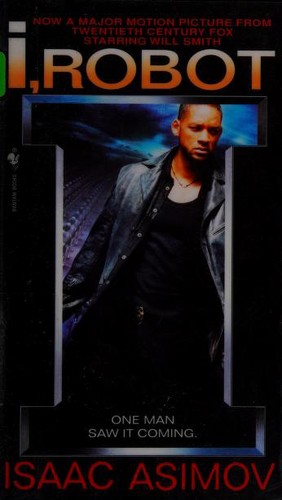Ashwin reviewed I, Robot by Isaac Asimov (The Robot Series)
Review of 'I, Robot' on 'Goodreads'
5 stars
(Crossposted from my blog: daariga.wordpress.com/2015/08/23/i-robot/)
It did not take too long into I, Robot for me to realize why it went far beyond every other science fiction book I had read. Isaac Asimov fails miserably in convincing the 21st century reader about the mechanics and the so called positronic brain of his futuristic robots. In fact, he does not even try. However, that does not matter because the 9 short stories in this book explore something quite extraordinary: robopsychology, the analysis of the thinking and behavior of robots governed by the Three Laws of Robotics. Published in science fiction magazines between 1940 and 1950, these stories span the lifetime of the prime character, a Dr. Susan Calvin, a robopsychologist at U.S. Robots and Mechanical Men. In each of these stories, Susan recalls an interesting problem or dilemma faced in robot-human interaction.
The stories are in chronological order of their timeline, starting off with simple robots used as nannies or servants at home. Due to social pressure, initially US Robots is not allowed to sell robots for employment on Earth. Instead they sell them for mining and maintenance tasks on asteroids, planets and spaceships. In these environments, typically some anomaly in robot behavior is observed. And by analysing the complex interplay between the three Laws of Robotics, the solution is figured out. Each of these is a clever puzzle that I felt highly relevant even today. In fact, I could easily analogize each into a real-time system or multi-threading or such computer science problem of today.
Towards the end of Susan’s life, in her last few stories, we are finally served robots on Earth, that are so intelligent that they run entire corporations or parts of Earth. With Asimov, the robot situation is never dystopian, like in Hollywood movies, thanks to the first Law of Robotics: a robot should not harm a human. Asimov really stretches imagination with the Machine, which acts as a benevolent administrator to hundreds of millions of humans. In this final story, I also see fragments of today’s Internet, search engines and the all-pervasive machine learning algorithms that we use with abandon.
These stories encompass new dimensions of vision and thinking about robots and our possible future life with them. It came as no surprise when I learnt that the term robotics itself was created by Asimov! The prose here is spare and elegant and the book is surprisingly easy to read considering its subject matter. Needles to say that I, Robot is a great introduction to Asimov and his Robot series and is a must read!
PS: The cover of the edition I read had this terrible Will Smith photo from his movie of the same name. (I have seen that atrocious movie and it has zero influence from this book.) It is quite pathetic how these book publishers are ready to make such vulgar covers of timeless classics, all for a quick buck!

